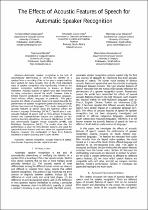JavaScript is disabled for your browser. Some features of this site may not work without it.
- ResearchSpace
- →
- Research Publications/Outputs
- →
- Journal Articles
- →
- View Item
| dc.contributor.author |
Mokgonyane, TB

|
|
| dc.contributor.author |
Sefara, Tshephisho J

|
|
| dc.contributor.author |
Manamela, MJ

|
|
| dc.contributor.author |
Modipa, TI

|
|
| dc.contributor.author |
Masekwameng, MS

|
|
| dc.date.accessioned | 2020-10-05T08:46:50Z | |
| dc.date.available | 2020-10-05T08:46:50Z | |
| dc.date.issued | 2020-08 | |
| dc.identifier.citation | Mokgonyane, T.B. (et.al). 2020 The effects of acoustic features of speech for automatic speaker recognition. 2020 International Conference on Artificial Intelligence, Big Data, Computing and Data Communication Systems, Durban, South Africa, 6-7 August 2020, 5pp. | en_US |
| dc.identifier.isbn | 978-1-7281-6770-1 | |
| dc.identifier.isbn | 978-1-7281-6769-5 | |
| dc.identifier.isbn | 978-1-7281-6771-8 | |
| dc.identifier.uri | https://ieeexplore.ieee.org/abstract/document/9183889 | |
| dc.identifier.uri | DOI: 10.1109/icABCD49160.2020.9183889 | |
| dc.identifier.uri | http://hdl.handle.net/10204/11587 | |
| dc.description | Copyright: 2020 IEEE. This is the preprint version of the work. For access to the published version, please access the publisher's website. | en_US |
| dc.description.abstract | Automatic speaker recognition is the task of automatically determining or verifying the identity of a speaker from a recording of his or her speech sample and has been studied for many decades. One of the most important steps of speaker recognition that significantly influences the speaker recognition performance is known as feature extraction. Acoustic features of speech have been researched by many researchers around the world, however, there is limited research conducted on African indigenous languages, South African official languages in particular. This paper presents the effects of acoustic features of speech towards the performance of speaker recognition systems focusing on South African low-resourced languages. This study investigates the acoustic features of speech using the National Centre for Human Language Technology (NCHLT) Sepedi speech data. Acoustic features of speech such as Time-domain, Frequency-domain and Cepstral-domain features are evaluated on four machine learning algorithms: K-Nearest Neighbours (K-NN), two kernel-based Support Vector Machines (SVM), and Multilayer Perceptrons (MLP). The results show that the performance is poor for time-domain features and good for spectral-domain features and even better for cepstral-domain features. However, the combination of these three features resulted in a higher accuracy and and F₁ score of 98%. | en_US |
| dc.language.iso | en | en_US |
| dc.publisher | IEEE | en_US |
| dc.relation.ispartofseries | Worklist;23774 | |
| dc.subject | Acoustic features of speech | en_US |
| dc.subject | Cepstral-domain | en_US |
| dc.subject | Frequency-domain | en_US |
| dc.subject | Speaker recognition | en_US |
| dc.subject | Time-domain | en_US |
| dc.title | The effects of acoustic features of speech for automatic speaker recognition | en_US |
| dc.type | Article | en_US |
| dc.identifier.apacitation | Mokgonyane, T., Sefara, T. J., Manamela, M., Modipa, T., & Masekwameng, M. (2020). The effects of acoustic features of speech for automatic speaker recognition. http://hdl.handle.net/10204/11587 | en_ZA |
| dc.identifier.chicagocitation | Mokgonyane, TB, Tshephisho J Sefara, MJ Manamela, TI Modipa, and MS Masekwameng "The effects of acoustic features of speech for automatic speaker recognition." (2020) http://hdl.handle.net/10204/11587 | en_ZA |
| dc.identifier.vancouvercitation | Mokgonyane T, Sefara TJ, Manamela M, Modipa T, Masekwameng M. The effects of acoustic features of speech for automatic speaker recognition. 2020; http://hdl.handle.net/10204/11587. | en_ZA |
| dc.identifier.ris | TY - Article AU - Mokgonyane, TB AU - Sefara, Tshephisho J AU - Manamela, MJ AU - Modipa, TI AU - Masekwameng, MS AB - Automatic speaker recognition is the task of automatically determining or verifying the identity of a speaker from a recording of his or her speech sample and has been studied for many decades. One of the most important steps of speaker recognition that significantly influences the speaker recognition performance is known as feature extraction. Acoustic features of speech have been researched by many researchers around the world, however, there is limited research conducted on African indigenous languages, South African official languages in particular. This paper presents the effects of acoustic features of speech towards the performance of speaker recognition systems focusing on South African low-resourced languages. This study investigates the acoustic features of speech using the National Centre for Human Language Technology (NCHLT) Sepedi speech data. Acoustic features of speech such as Time-domain, Frequency-domain and Cepstral-domain features are evaluated on four machine learning algorithms: K-Nearest Neighbours (K-NN), two kernel-based Support Vector Machines (SVM), and Multilayer Perceptrons (MLP). The results show that the performance is poor for time-domain features and good for spectral-domain features and even better for cepstral-domain features. However, the combination of these three features resulted in a higher accuracy and and F₁ score of 98%. DA - 2020-08 DB - ResearchSpace DP - CSIR KW - Acoustic features of speech KW - Cepstral-domain KW - Frequency-domain KW - Speaker recognition KW - Time-domain LK - https://researchspace.csir.co.za PY - 2020 SM - 978-1-7281-6770-1 SM - 978-1-7281-6769-5 SM - 978-1-7281-6771-8 T1 - The effects of acoustic features of speech for automatic speaker recognition TI - The effects of acoustic features of speech for automatic speaker recognition UR - http://hdl.handle.net/10204/11587 ER - | en_ZA |






